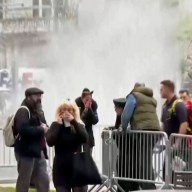ZHUKOVSKY, Russia – Prime Minister Vladimir Putin pledged billions more in government funding to support Russia’s aging aerospace industries at the opening of the country’s largest air show Tuesday, two days after a fatal air force crash.
The International Aviation and Space Show’s opening has been overshadowed by Sunday’s collision of two air force stunt jets, which killed the leader of an elite aerobatic squadron, as they practiced for the exposition.
Putin praised the victim as one of Russia’s best pilots and honoured him with a moment of silence.
The global economic downturn also cast a pall over the show, as analysts expect few major commercial deals to be signed during the weeklong event held at a military airfield near Moscow.
The show, known by its Russian acronym MAKS, is the biennial showcase for scores of state and private defence companies.
Putin promised that the government would earmark significant resources to upgrade the nation’s aerospace industries and help them extend their share of the global market.
“The development of the aviation and space industries is one of our priorities,” he said in remarks opening the show. “We are pinning our hopes for diversification of the national economy and expansion of its high-tech sector on them.”
Putin later watched as fighter jets and helicopters roared overhead, tumbling and spinning in acrobatic manoeuvrs, then toured rows of pavilions featuring everything from flight simulators to missile defence systems to parachutes.
Despite similar pledges by Putin to modernize the aircraft industry during his eight years as president, many have continued to rely on aging equipment and have been slow to produce new planes, military or civilians.
Russia has failed to develop a new fighter jet to match the latest U.S. fighter, the F-22 Raptor, which entered service in 2005. Officials have pledged that the new Russian fighter will make its maiden flight later this year.
The top Russian fighter in the show, the Su-35, is only an upgrade of the Su-27, which has been the mainstay of the Soviet and then Russian air force for nearly a quarter century.
The Defence Ministry announced it would buy 64 Sukhoi fighters, including 48 Su-35, by 2015 in a deal it estimated at $65 million.
Top aircraft makers such as Sukhoi have survived mostly thanks to lucrative export orders for their fighter jets from China, India and other foreign customers.
Seeking new markets, Sukhoi has developed a regional passenger jet, the Superjet 100, which made its Russian public debut at the show. The company says orders for the plane – designed to compete with Brazil’s Embraer and Canada’s Bombadier midrange jets – have reached 122 aircraft.
Other leading Russian aircraft makers, such as Tupolev and Ilyushin, have been far less successful than Sukhoi in seeking customers both in Russia and abroad.
Russian airlines have ignored their products, opting increasingly for Boeings and Airbuses. Even Russia’s industry minister has acknowledged earlier this month that there is no domestic demand for Tupolev and Ilyushin planes.
















